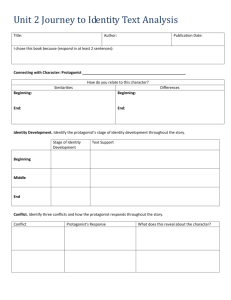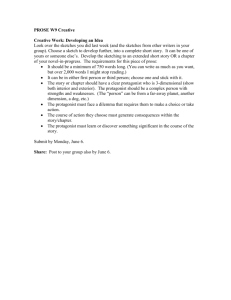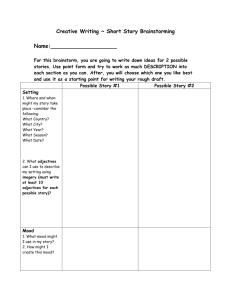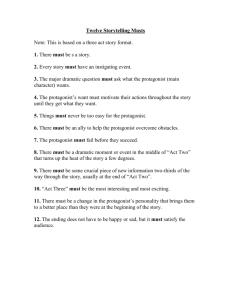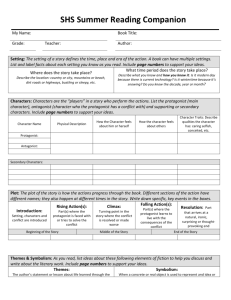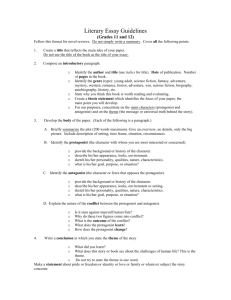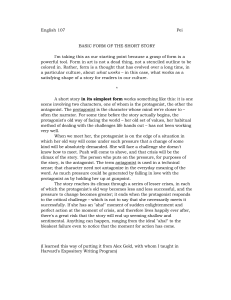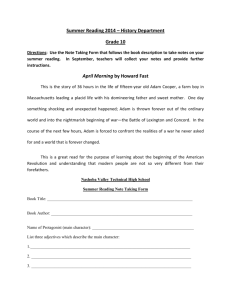Fiction Elements: Story Chart & Discussion Questions
advertisement
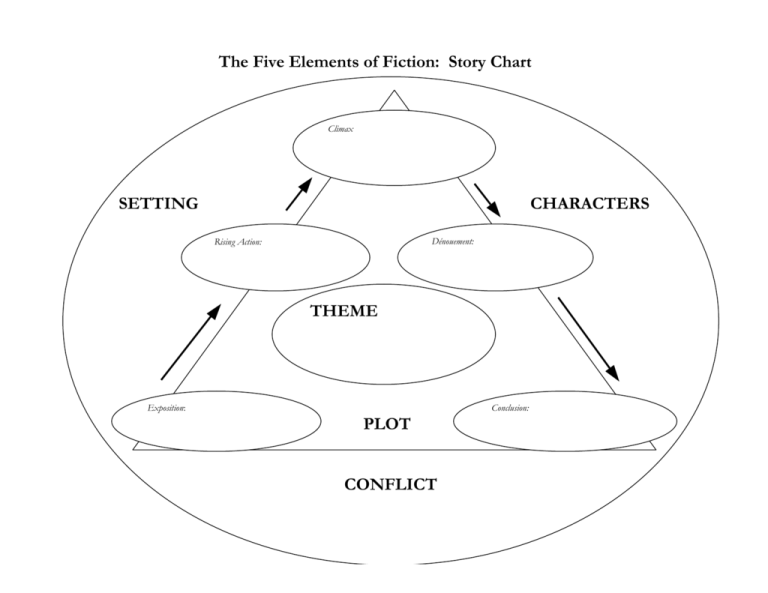
The Five Elements of Fiction: Story Chart Climax SETTING CHARACTERS Dénouement: Rising Action: THEME Exposition: Conclusion: PLOT CONFLICT QUESTIONS FOR DISCUSSION PLOT: 1. What happens in the story? a. What major events take place in the story as a result of the conflict? b. How do the protagonist and the antagonist respond to the conflict at first? Do these actions provoke further conflict? c. How do the interactions of the characters heighten the tension of the conflict that exists? d. What external impulses heighten the conflict – weather, war, summer break, separation, sickness, etc? 2. How is the main problem solved? a. How are the protagonist’s obstacles finally overcome? b. Is the situation pleasantly resolved, or is it resolved in a terrible way? c. What events form the highest point or climax of the story’s tension? Are they circumstantial events, or emotional ones? Is the climax a spiritual or physical one? d. Does the protagonist solve his own dilemma? Is it solved by some external source or 3rd party? Is he helpless in the end to achieve his goal (like Frodo in Lord of the Rings), or does he triumph by virtue of his own efforts (Odysseus in The Odyssey)? 3. How does the story end? a. Were you satisfied with the resolution? If not, why not? b. How does the solution of the conflict affect each individual character? c. Does the ending or resolution of the story make any kind of judgments? CONFLICT: 4. What does the protagonist want? a. Fill in the blank: This story is about the protagonist trying to ________. b. Does he attempt to overcome something – a physical impediment, or an emotional handicap? c. Is the conflict an external one, having to do with circumstances in the protagonist’s physical world, or is it an internal conflict, taking place in his mind and emotions? d. Do his objectives or goals change throughout the story? How? Why? 5. Why can’t he have it? a. Does the protagonist lack strength, mental acumen or some other necessary ability? b. Does he lack self-confidence, good health, or social connections? c. Is the conflict a man v. man struggle? What kind of struggle is it? SETTING: 6. Where does this story happen? a. Does the story happen in the country or the city? b. What is the mood or atmosphere of the place where the story happens? Is it cheerful and sunny, or dark and bleak? What words or phrases or descriptions does the author use to create this atmosphere? c. Among what kinds of people is the story set? What is their economic class? How do they live? Are they hopeful? Downtrodden? Depressed? Why? 7. When does this story happen? a. How long a period of time does the story cover? A few minutes? A single day? A whole lifetime? b. In what time of life for the main characters do the events occur? Are they children? Are they just passing into adulthood? Are they already grownups? Does setting the story in this particular time of the characters’ lives make the story better? CHARACTERS: 8. Who is the story about? a. How old is the protagonist? b. Is the protagonist male or female? c. Is the character kind, gentle, stern, emotional, harsh, logical, rational, compassionate or exacting…? Make up a list of adjectives that describe the protagonist. What words or actions on the protagonist’s part make you choose the adjectives you do? d. Of what nationality is the protagonist? Does he live in his native land, or somewhere else? e. What does the character say about himself to other people? f. What do other characters think or say about him? g. Do the protagonist’s priorities change over the course of the story? In what way? What causes this change? Is it a change for the better, or for the worse? h. Is the protagonist a type or archetype? Is he an “Everyman” with whom the reader is meant to identify? Are his struggles symbolic of human life generally in some way? i. Is the protagonist a sympathetic character? Do you identify with him and hope he will succeed? Do you pity him? Do you scorn or despise his weakness in some way? Why? THEME: 9. What does the main character learn? (Theme) a. Is he changed in his mind or heart by the events of the story? 10. What is the main idea of the story? (Theme) a. Does the story seem to deal with one of the universal themes listed in lesson 6 of this syllabus? b. Does the story offer an answer to a particular problem associated with one of those themes? c. Does the story merely call the reader’s attention to a theme without trying to solve anything? d. What answer does the story seem to suggest for the question, “What is a good life?” e. What aspect of the human condition is brought to light and wondered at in this story?
